Seasonal Variation in Total Cloud Cover and Cloud Type Characteristics in Xinjiang, China Based on FY-4A
Abstract
:1. Introduction
2. Data and Methodology
2.1. Study Area
2.2. Dataset
2.3. Methodology
3. Results
3.1. Seasonal Variation in Total Cloud Cover
3.2. Seasonal Variation in Cloud Type
3.3. Correlations between Total Cloud Cover and Water Vapor
4. Discussion
5. Conclusions
Author Contributions
Funding
Data Availability Statement
Acknowledgments
Conflicts of Interest
References
- Zhou, C.; Zelinka, M.D.; Klein, S.A. Impact of decadal cloud variations on the Earth’s energy budget. Nat. Geosci. 2016, 9, 871–874. [Google Scholar] [CrossRef]
- Butt, N.; New, M.; Malhi, Y.; da Costa, A.C.L.; Oliveira, P.; Silva-Espejo, J.E. Diffuse radiation and cloud fraction relationships in two contrasting Amazonian rainforest sites. Agric. For. Meteorol. 2010, 150, 361–368. [Google Scholar] [CrossRef]
- Zelinka, M.D.; Hartmann, D.L. Why is longwave cloud feedback positive? J. Geophys. Res. Atmos. 2010, 115, 1–16. [Google Scholar] [CrossRef]
- Ramanathan, V.; Crutzen, P.J.; Kiehl, J.T.; Rosenfeld, D. Aerosols, climate, and the hydrological cycle. Science 2001, 294, 2119–2124. [Google Scholar] [CrossRef] [PubMed]
- Stephens, G.L. Cloud feedbacks in the climate system: A critical review. J. Clim. 2005, 18, 237–273. [Google Scholar] [CrossRef]
- Stephens, G.L.; Vane, D.G.; Boain, R.J.; Mace, G.G.; Sassen, K.; Wang, Z.; Mitrescu, C. The cloudsat mission and the A-train—A new dimension of space-based observations of clouds and precipitation. Bull. Am. Meteorol. Soc. 2002, 83, 1771–1790. [Google Scholar] [CrossRef]
- Brient, F.; Schneider, T.; Tan, Z.; Bony, S.; Qu, X.; Hall, A. Shallowness of tropical low clouds as a predictor of climate models’ response to warming. Clim. Dynam. 2016, 47, 433–449. [Google Scholar] [CrossRef]
- Wang, T.; Wong, S.; Fetzer, E.J. Cloud regime evolution in the Indian monsoon intraseasonal oscillation: Connection to large-scale dynamical conditions and the atmospheric water budget. Geophys. Res. Lett. 2015, 42, 9465–9472. [Google Scholar] [CrossRef]
- Liu, Y.; Wu, W.; Jensen, M.P.; Toto, T. Relationship between cloud radiative forcing, cloud fraction and cloud albedo, and new surface-based approach for determining cloud albedo. Atmos. Chem. Phys. 2011, 11, 7155–7170. [Google Scholar] [CrossRef]
- Moron, V.; Camberlin, P.; Aellig, R.; Champagne, O.; Fink, A.H.; Knippertz, P.; Philippon, N. Diurnal to interannual variability of low-level cloud cover over western equatorial Africa in May–October. Int. J. Climatol. 2023, 43, 6038–6064. [Google Scholar] [CrossRef]
- Li, J.; Mao, J.; Wang, F. Comparative study of five current reanalyses in characterizing total cloud fraction and top-of-the-atmosphere cloud radiative effects over the Asian monsoon region. Int. J. Climatol. 2017, 37, 5047–5067. [Google Scholar] [CrossRef]
- Zhao, W.; Zhang, N.; Sun, J. Spatiotemporal variations of cloud amount over the Yangtze River Delta, China. J. Meteorol. Res. 2014, 28, 371–380. [Google Scholar] [CrossRef]
- Wu, H.; Xu, X.; Luo, T.; Yang, Y.; Xiong, Z.; Wang, Y. Variation and comparison of cloud cover in MODIS and four reanalysis datasets of ERA-interim, ERA5, MERRA-2 and NCEP. Atmos. Res. 2023, 281, 106477. [Google Scholar] [CrossRef]
- Matuszko, D.; Bartoszek, K.; Soroka, J. Long-term variability of cloud cover in Poland (1971–2020). Atmos. Res. 2022, 268, 106028. [Google Scholar] [CrossRef]
- Deng, C.; Li, J.; Li, J.; Li, R.; Zhang, W.; Zhao, Y.; Zhao, Y.X.; Jian, B. Long-term changes in the diurnal cycle of total cloud cover over the Tibetan Plateau. Atmos. Res. 2023, 295, 106992. [Google Scholar] [CrossRef]
- Sun, B.; Free, M.; Yoo, H.L.; Foster, M.J.; Heidinger, A.; Karlsson, K.G. Variability and trends in US cloud cover: ISCCP, PATMOS-x, and CLARA-A1 compared to homogeneity-adjusted weather observations. J. Clim. 2015, 28, 4373–4389. [Google Scholar] [CrossRef]
- Free, M.; Sun, B.; Yoo, H.L. Comparison between total cloud cover in four reanalysis products and cloud measured by visual observations at US weather stations. J. Clim. 2016, 29, 2015–2021. [Google Scholar] [CrossRef]
- Lei, Y.; Letu, H.; Shang, H.; Shi, J. Cloud cover over the Tibetan Plateau and eastern China: A comparison of ERA5 and ERA-Interim with satellite observations. Clim. Dynam. 2020, 54, 2941–2957. [Google Scholar] [CrossRef]
- Dommo, A.; Philippon, N.; Vondou, D.A.; Sèze, G.; Eastman, R. The June–September low cloud cover in western central Africa: Mean spatial distribution and diurnal evolution, and associated atmospheric dynamics. J. Clim. 2018, 31, 9585–9603. [Google Scholar] [CrossRef]
- Bao, S.; Letu, H.; Zhao, J.; Shang, H.; Lei, Y.; Duan, A.; Shi, J. Spatiotemporal distributions of cloud parameters and their response to meteorological factors over the Tibetan Plateau during 2003–2015 based on MODIS data. Int. J. Climatol. 2019, 39, 532–543. [Google Scholar] [CrossRef]
- Barnes, M.L.; Miura, T.; Giambelluca, T.W. An assessment of diurnal and seasonal cloud cover changes over the Hawaiian Islands using Terra and Aqua MODIS. J. Clim. 2016, 29, 77–90. [Google Scholar] [CrossRef]
- Ahmadi, M.; Dadashi-Roudbari, A.; Akbari-Azirani, T.; Nasiri-Khuzani, B. Seasonal and annual segregation of liquid water and ice clouds in Iran and their relation to geographic components and precipitation. Theor. Appl. Climatol. 2020, 140, 963–982. [Google Scholar] [CrossRef]
- Manara, V.; Brunetti, M.; Wild, M.; Maugeri, M. Variability and trends of the total cloud cover over Italy (1951–2018). Atmos. Res. 2023, 285, 106625. [Google Scholar] [CrossRef]
- Chen, Y.; Li, W.; Deng, H.; Fang, G.; Li, Z. Changes in Central Asia’s Water Tower: Past, present and future. Sci. Rep. 2016, 6, 35458. [Google Scholar] [CrossRef] [PubMed]
- Zhang, J.B.; Deng, Z.F. A Generality of Rainfall in Xinjiang; Meteorological Press: Beijing, China, 1987; pp. 1–10. (In Chinese) [Google Scholar]
- Yang, L.M.; Li, X.; Zhang, G.X. Some advances and problems in the study of heavy rain in Xinjiang. Clim. Environ. Res. 2011, 16, 188–198. (In Chinese) [Google Scholar]
- Zeng, Y.; Yang, L. Triggering mechanism of an extreme rainstorm process near the Tianshan Mountains in Xinjiang, an arid region in China, based on a numerical simulation. Adv. Meteorol. 2020, 2020, 8828060. [Google Scholar] [CrossRef]
- Zeng, Y.; Tong, Z.; Jiang, Y.; Zhou, Y. Microphysical characteristics of seasonal rainfall observed by a Parsivel disdrometer in the Tianshan Mountains, China. Atmos. Res. 2022, 280, 106459. [Google Scholar] [CrossRef]
- Zeng, Y.; Yang, L.; Zhou, Y.; Tong, Z.; Jiang, Y. Statistical characteristics of summer season raindrop size distribution in the western and central Tianshan Mountains in China. J. Meteor. Soc. Jpn. 2022, 100, 855–872. [Google Scholar] [CrossRef]
- Zeng, Y.; Yang, L.; Zhou, Y.; Tong, Z.; Jiang, Y.; Chen, P. Characteristics of orographic raindrop size distribution in the Tianshan Mountains, China. Atmos. Res. 2022, 278, 106332. [Google Scholar] [CrossRef]
- Zeng, Y.; Yang, L.; Tong, Z.; Jiang, Y.; Chen, P.; Zhou, Y. Characteristics and applications of summer season raindrop size distributions based on a PARSIVEL2 disdrometer in the western Tianshan Mountains (China). Remote Sens. 2022, 14, 3988. [Google Scholar] [CrossRef]
- Zeng, Y.; Li, J.; Yang, L.; Li, H.; Li, X.; Tong, Z.; Jiang, Y.; Liu, J.; Zhang, J.; Zhou, Y. Microphysical characteristics of raindrop size distribution and implications for dual-polarization radar quantitative precipitation estimations in the Tianshan Mountains, China. Remote Sens. 2023, 15, 2668. [Google Scholar] [CrossRef]
- Zeng, Y.; Yang, L.; Li, J.; Jiang, Y.; Tong, Z.; Li, X.; Li, H.; Liu, J.; Lu, X.; Zhou, Y. Seasonal variation of microphysical characteristics for different rainfall types in the Tianshan Mountains of China. Atmos. Res. 2023, 295, 107024. [Google Scholar] [CrossRef]
- Zeng, Y.; Yang, L.; Zhang, Z.; Tong, Z.; Li, J.; Liu, F.; Zhang, J.; Jiang, Y. Characteristics of clouds and raindrop size distribution in Xinjiang, using cloud radar datasets and a disdrometer. Atmosphere 2020, 11, 1382. [Google Scholar] [CrossRef]
- Zhang, J.; Li, H.; Zeng, Y.; Yang, L.; Li, J. Macro-and microphysical characteristics of snowfall and non-snowfall clouds in the West Tianshan Mountains of China based on cloud radar. Meteorol. Atmos. Phys. 2022, 134, 98. [Google Scholar] [CrossRef]
- Duan, A.; Wu, G. Change of cloud amount and the climate warming on the Tibetan Plateau. Geophys. Res. Lett. 2006, 33, L2270. [Google Scholar] [CrossRef]
- Free, M.; Sun, B. Trends in US total cloud cover from a homogeneity-adjusted dataset. J. Clim. 2014, 27, 4959–4969. [Google Scholar] [CrossRef]
- Min, M.; Wu, C.; Li, C.; Liu, H.; Xu, N.; Wu, X.; Chen, L.; Wang, F.; Sun, F.; Qin, D.; et al. Developing the science product algorithm testbed for Chinese next-generation geostationary meteorological satellites: Fengyun-4 series. J. Meteorol. Res. 2017, 31, 708–719. [Google Scholar] [CrossRef]
- Wang, X.; Min, M.; Wang, F.; Guo, J.; Li, B.; Tang, S. Intercomparisons of cloud mask products among fengyun-4a, himawari-8, and modis. IEEE Trans. Geosci. Remote Sens. 2019, 57, 8827–8839. [Google Scholar] [CrossRef]
- Xu, W.; Lyu, D. Evaluation of cloud mask and cloud top height from Fengyun-4A with MODIS cloud retrievals over the Tibetan Plateau. Remote Sens. 2021, 13, 1418. [Google Scholar] [CrossRef]
- Yang, J.; Zhang, Z.; Wei, C.; Lu, F.; Guo, Q. Introducing the new generation of Chinese geostationary weather satellites, Fengyun-4. Bull. Am. Meteorol. Soc. 2017, 98, 1637–1658. [Google Scholar] [CrossRef]
- Schmit, T.J.; Griffith, P.; Gunshor, M.M.; Daniels, J.M.; Goodman, S.J.; Lebair, W.J. A closer look at the abi on the goes-r series. Bull. Am. Meteorol. Soc. 2017, 98, 681–698. [Google Scholar] [CrossRef]
- Bessho, K.; Date, K.; Hayashi, M.; Ikeda, A.; Imai, T.; Inoue, H.; Kumagai, Y.; Miyakawa, T.; Murata, H.; Ohno, T.; et al. An introduction to himawari-8/9-japan’s new-generation geostationary meteorological satellites. J. Meteorol. Soc. Jpn. 2016, 94, 151–183. [Google Scholar] [CrossRef]
- Lai, R.; Teng, S.; Yi, B.; Letu, H.; Min, M.; Tang, S.; Liu, C. Comparison of cloud properties from Himawari-8 and FengYun-4A geostationary satellite radiometers with MODIS cloud retrievals. Remote Sens. 2019, 11, 1703. [Google Scholar] [CrossRef]
- Chen, Y.; Li, W.; Chen, S.; Zhang, A.; Fu, Y. Linkage between the vertical evolution of clouds and droplet growth modes as seen from FY-4A AGRI and GPM DPR. Geophys. Res. Lett. 2020, 47, e2020GL088312. [Google Scholar] [CrossRef]
- Liu, X.; Wang, Y.; Huang, J.; Yu, T.; Jiang, N.; Yang, J.; Zhan, W. Assessment and calibration of FY-4A AGRI total precipitable water products based on CMONOC. Atmos. Res. 2022, 271, 106096. [Google Scholar] [CrossRef]
- Zhou, Y.; Wang, X.; Xu, C. Comprehensive evaluation of the precipitable water vapor products of Fengyun satellites via GNSS data over mainland China. Atmos. Res. 2024, 300, 107235. [Google Scholar] [CrossRef]
- Shi, B.; Yang, C.; Min, J.; Sha, L. Impact of a new bias correction predictor for FY-4A AGRI all-sky data assimilation on typhoon forecast. J. Geophys. Res. Atmos. 2023, 128, e2023JD039063. [Google Scholar] [CrossRef]
- Wang, M.; Chen, Y.; Zhou, Y.; Li, Q. Comparative analysis of application effects of three cloud parameters of FY-4A in a rainstorm case. Torrential Rain Disasters 2022, 41, 396–404. (In Chinese) [Google Scholar]
- Zhang, Q.; Ren, J.; Xiao, H.; Wang, J.; Xiao, D. Characteristics of MCC from convective initiation to mature stage over the Sichuan basin based on FY-4A satellite data. Chin. J. Atmos. Sci. 2021, 45, 863–873. (In Chinese) [Google Scholar]
- Cui, L.; Guo, W.; Ge, W.; Yan, Y.; Luo, S. Comparisons of cloud top parameter of FY-4A satellite and its typhoon application research. Plateau Meteorol. 2020, 39, 196–203. (In Chinese) [Google Scholar]
- Chen, F.; Yu, Z.; Yang, M.; Ito, E.; Wang, S.; Madsen, D.B.; Wünnemann, B. Holocene moisture evolution in arid central Asia and its out-of-phase relationship with Asian monsoon history. Quat. Sci. Rev. 2008, 27, 351–364. [Google Scholar] [CrossRef]
- Huang, W.; Feng, S.; Chen, J.; Chen, F. Physical mechanisms of summer precipitation variations in the Tarim Basin in northwestern China. J. Clim. 2015, 28, 3579–3591. [Google Scholar] [CrossRef]
- Wu, W.; Liu, Y.; Betts, A.K. Observationally based evaluation of NWP reanalyses in modeling cloud properties over the Southern Great Plains. J. Geophys. Res. 2012, 117, D12202. [Google Scholar]
- Wu, W.; Liu, Y.; Jensen, M.P.; Toto, T.; Foster, M.J.; Long, C.N. A comparison of multiscale variations of decade-long cloud fractions from six different platforms over the Southern Great Plains in the United States. J. Geophys. Res. Atmos. 2014, 119, 3438–3459. [Google Scholar] [CrossRef]
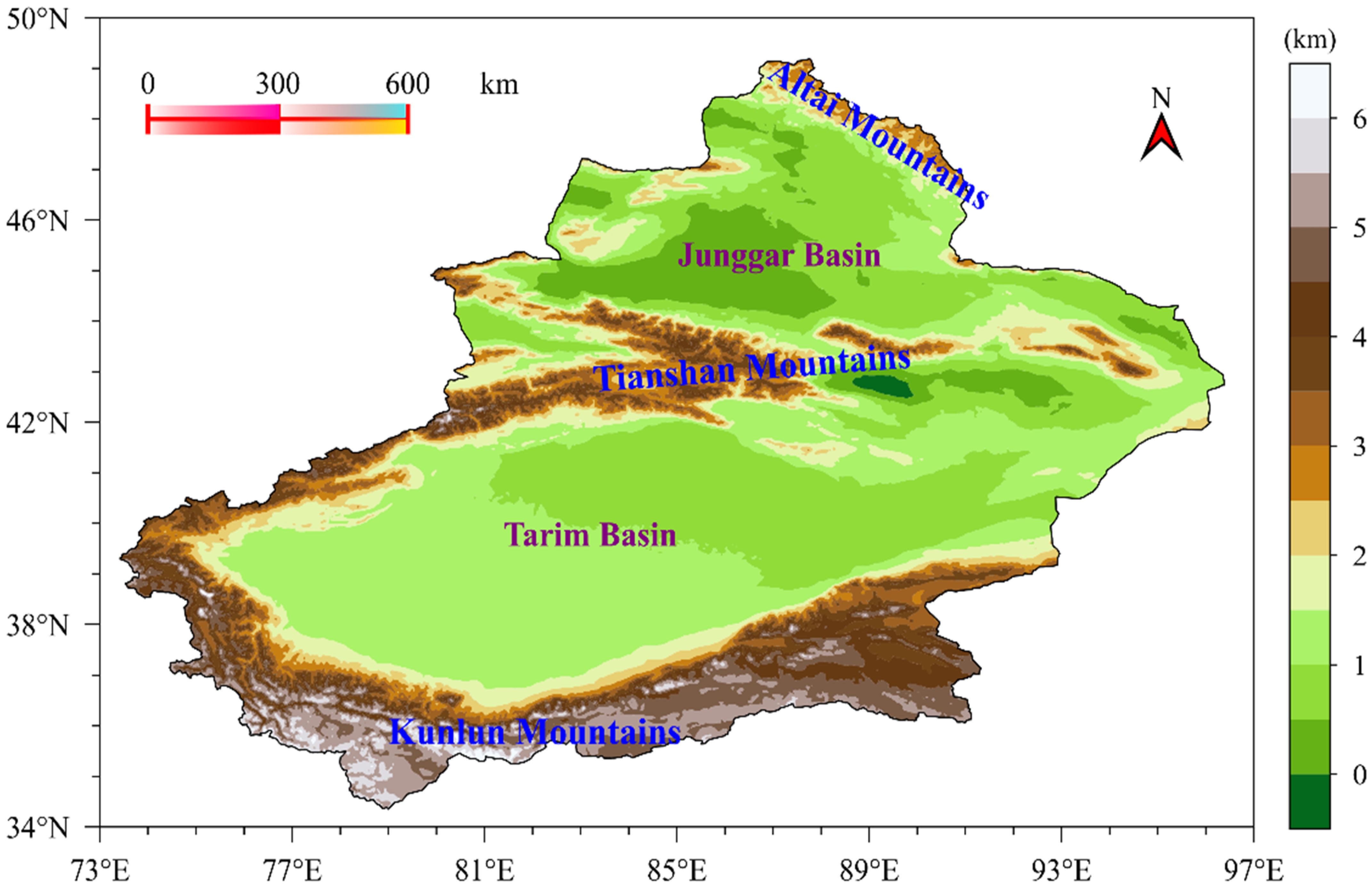
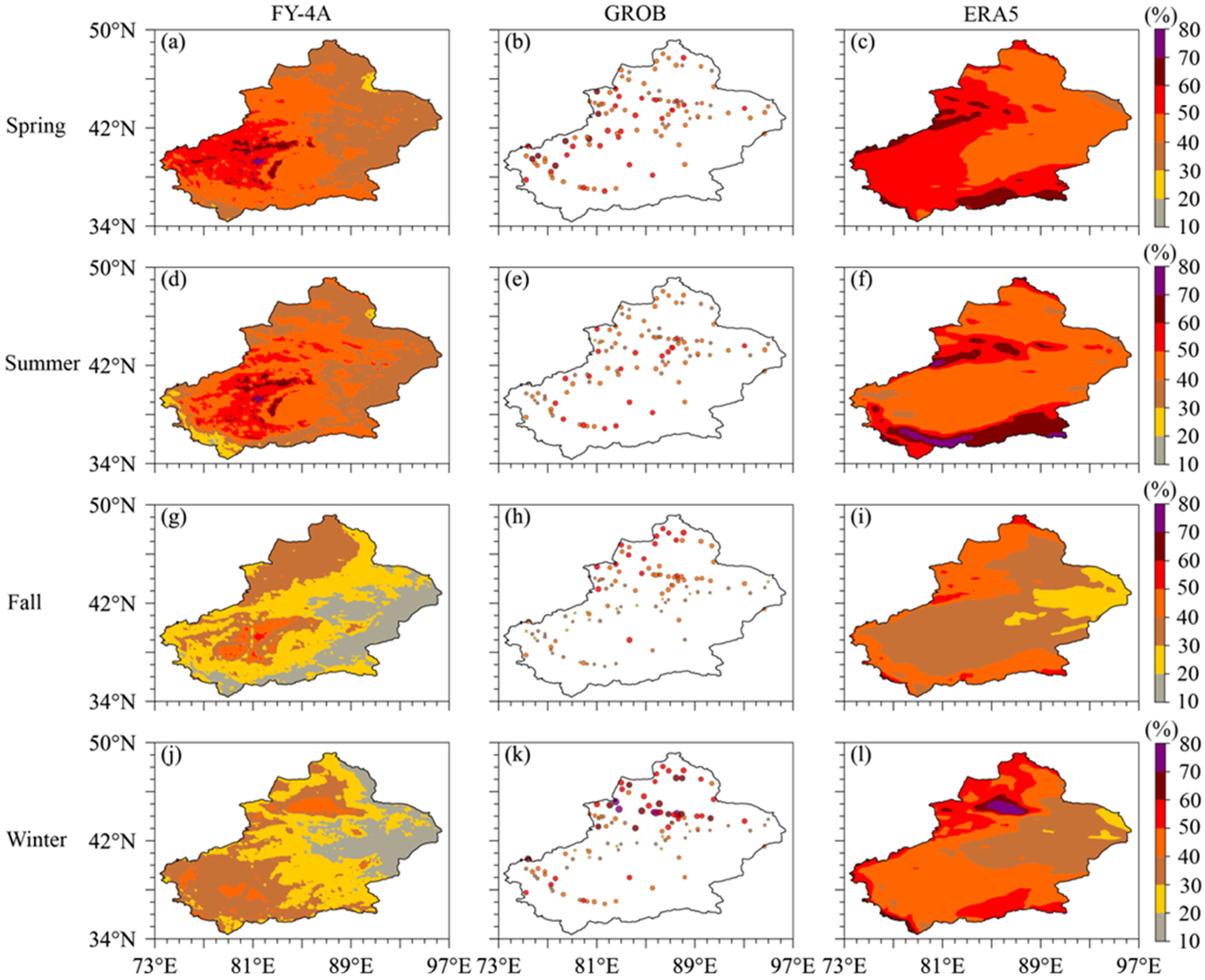




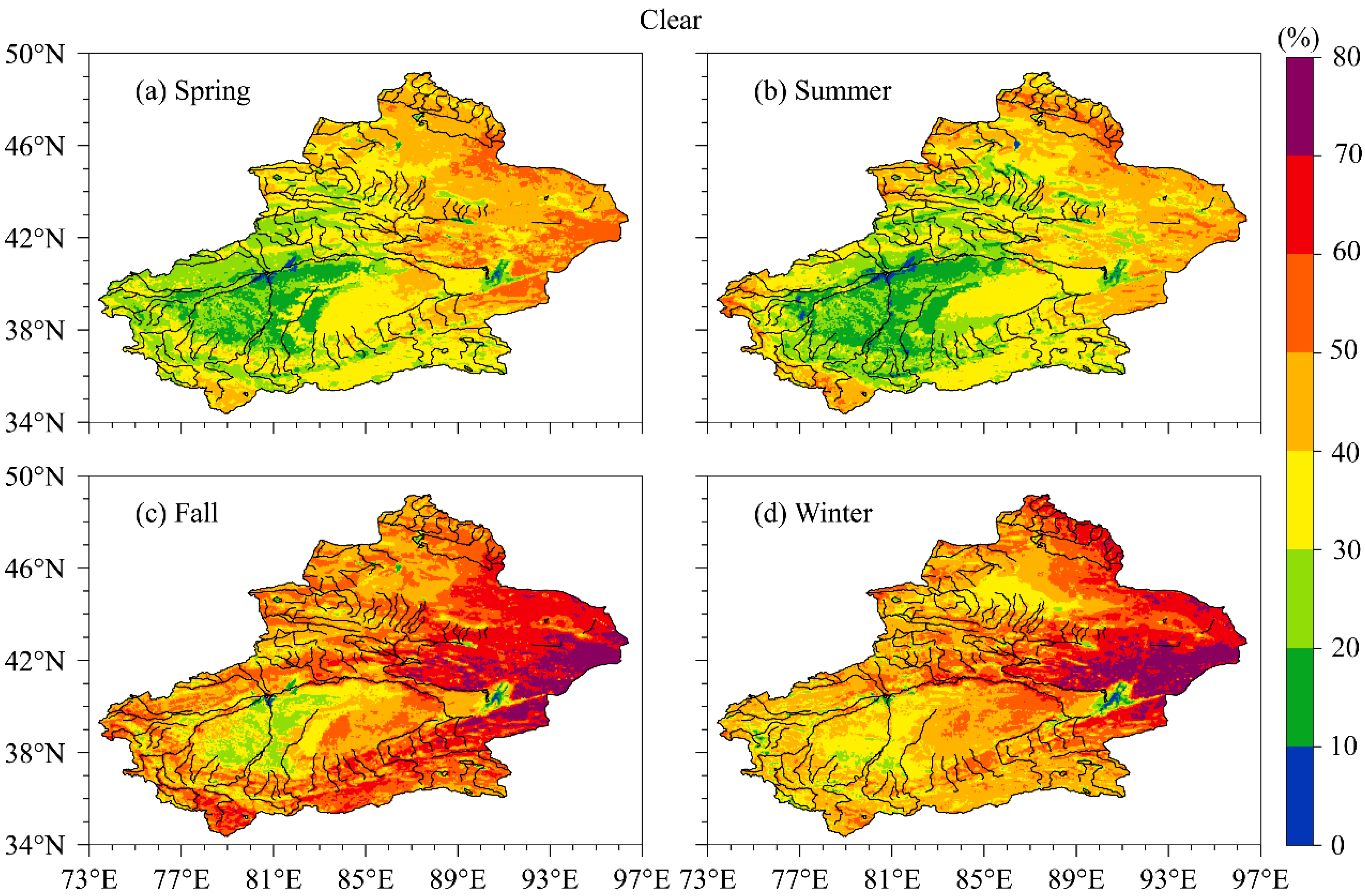
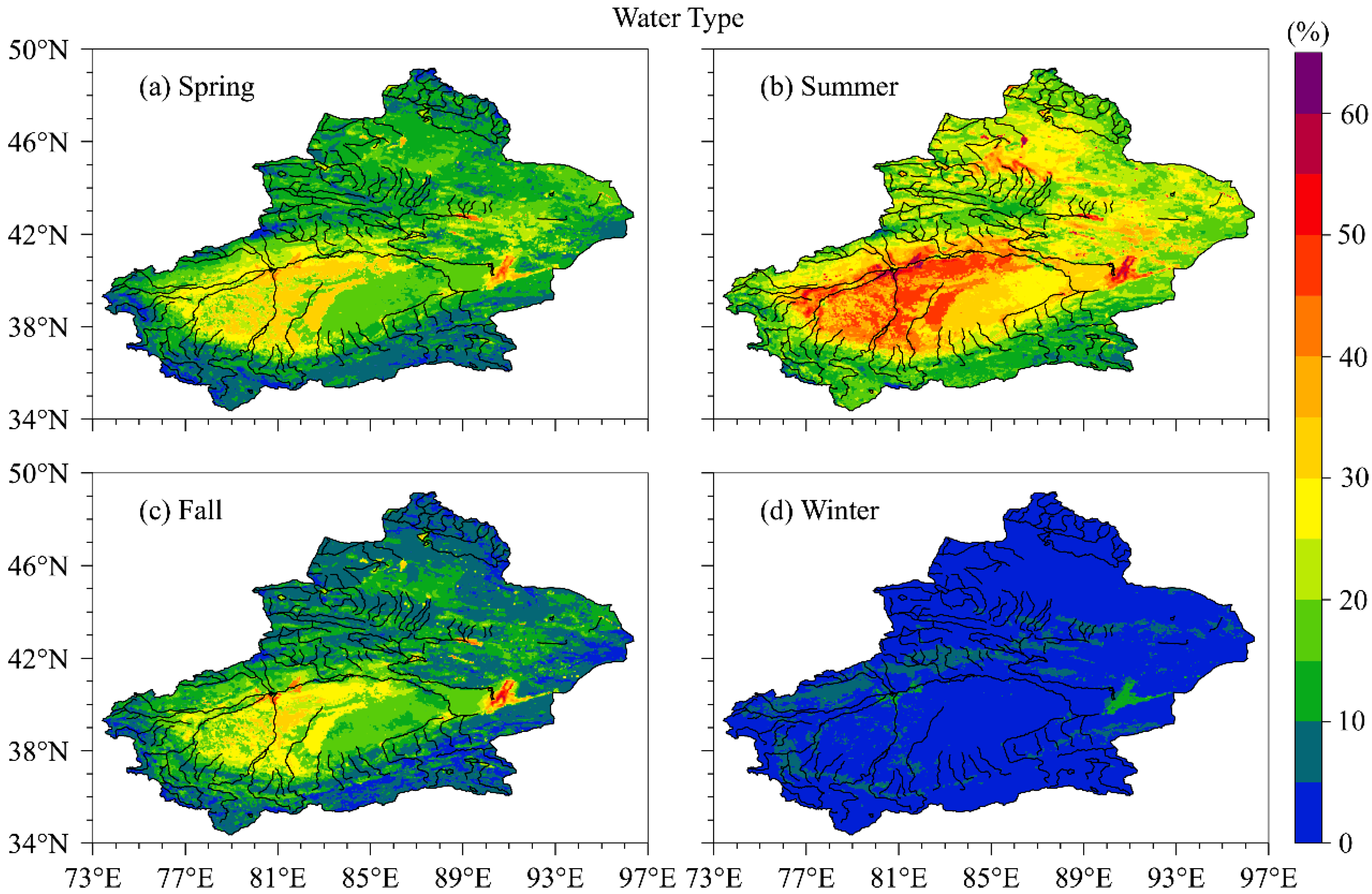
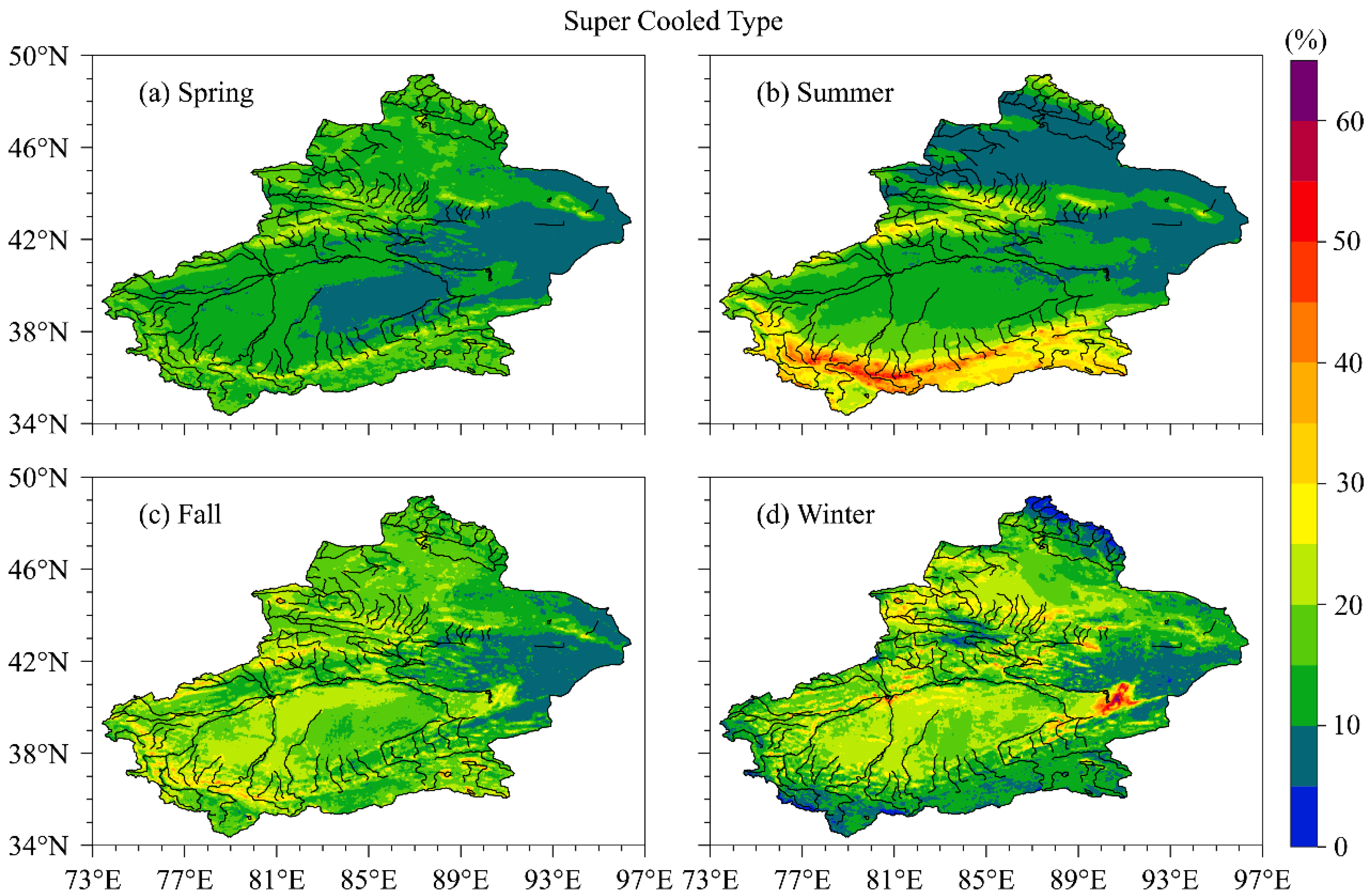
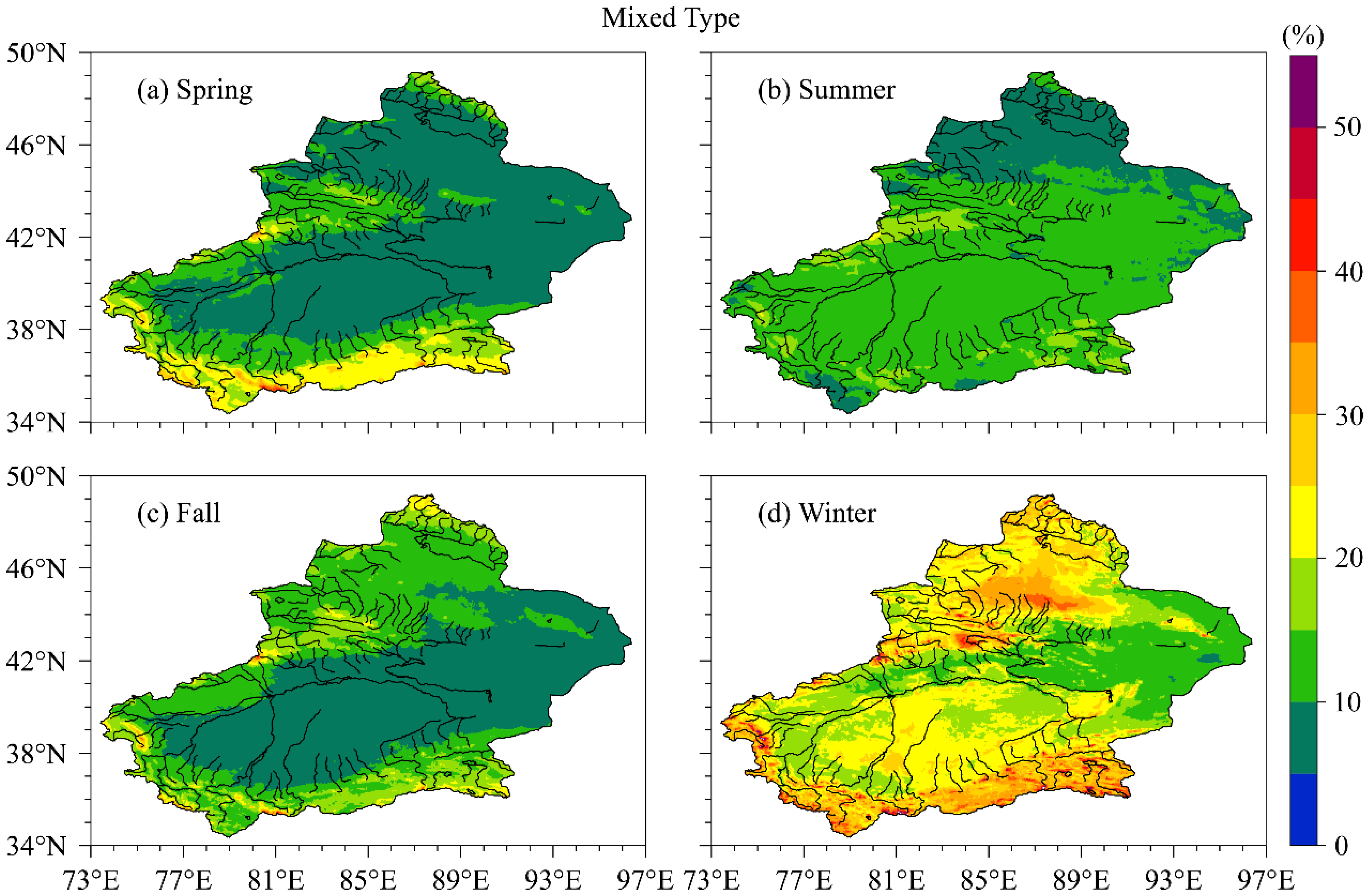
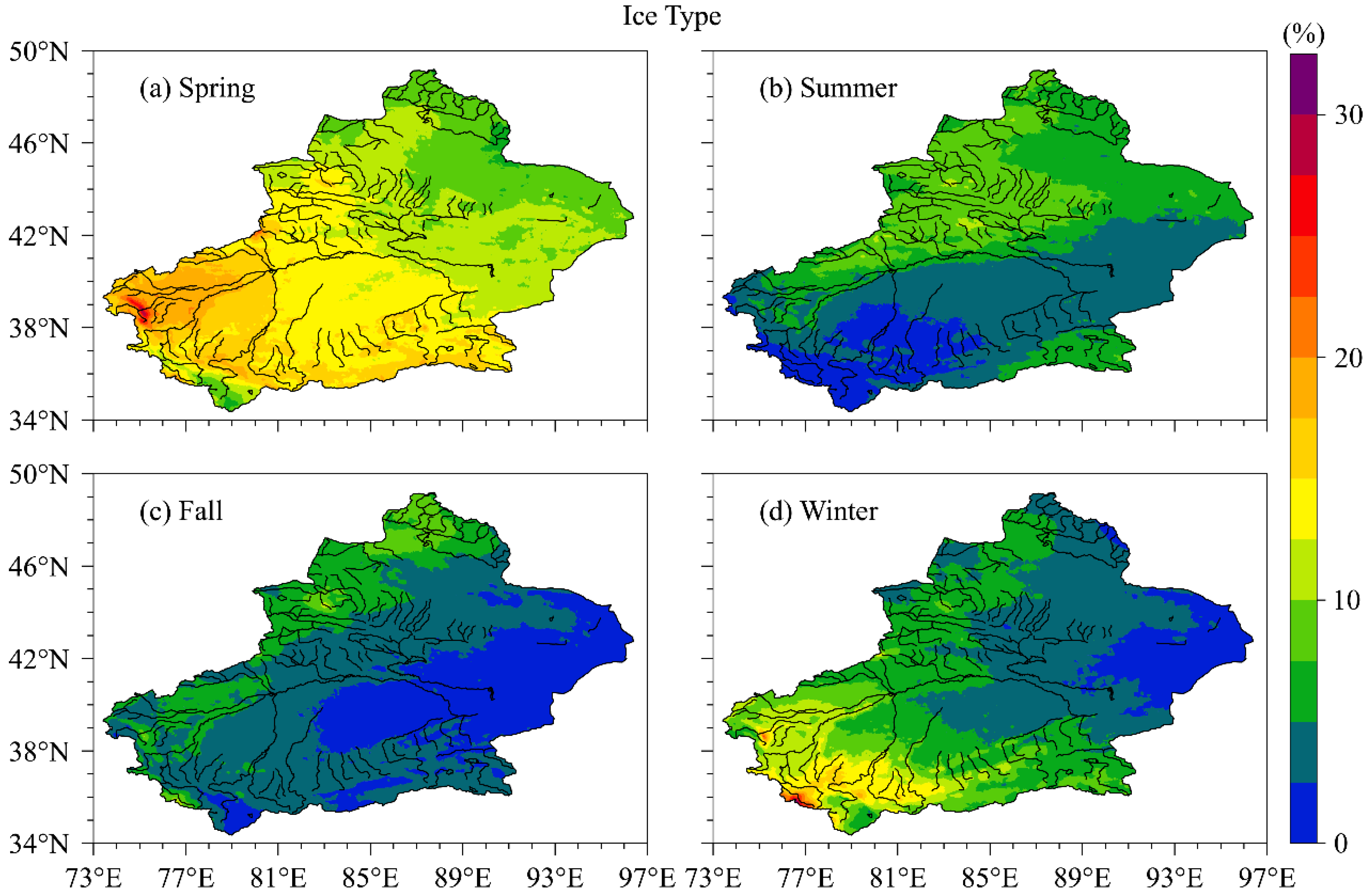

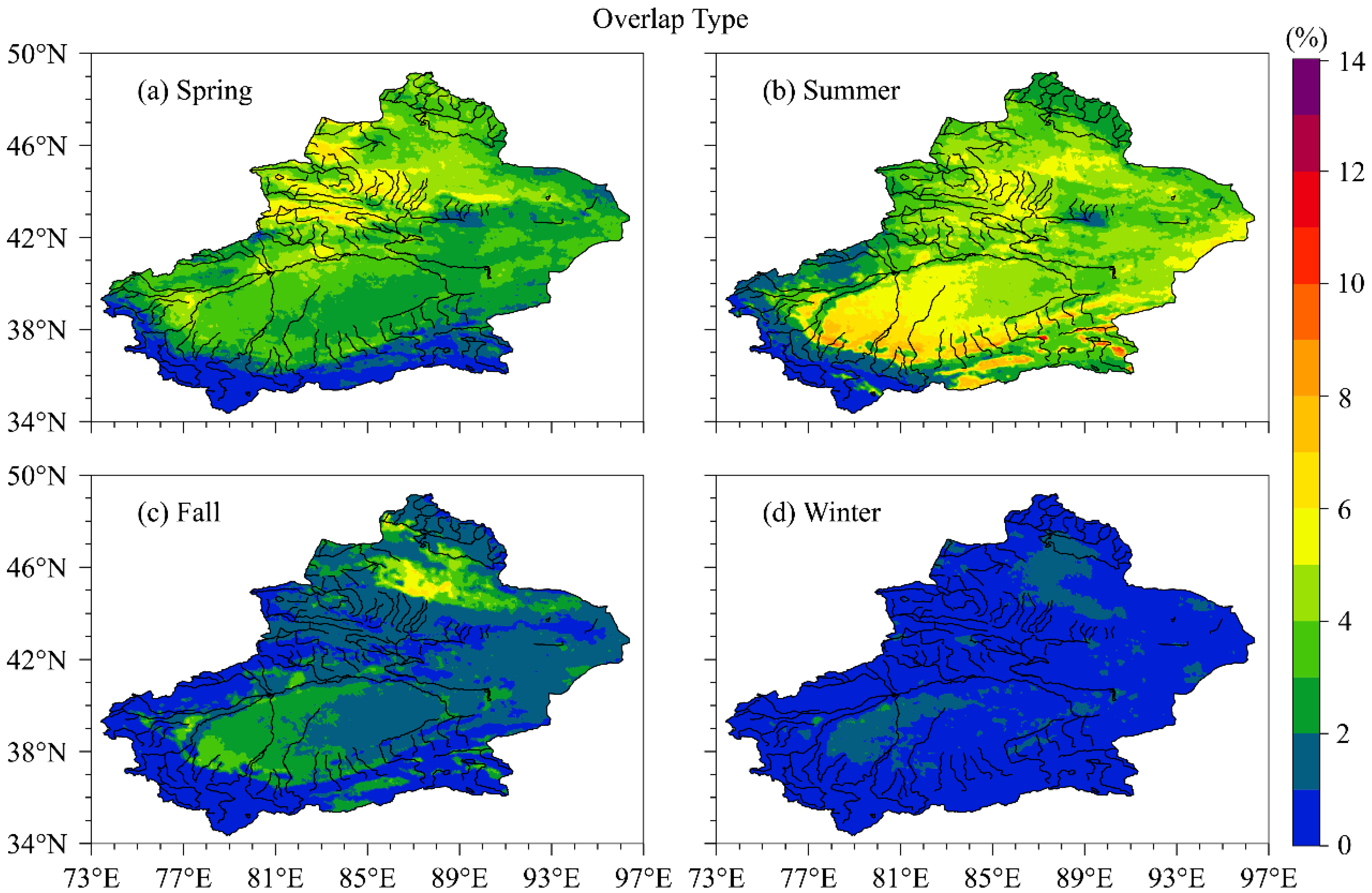

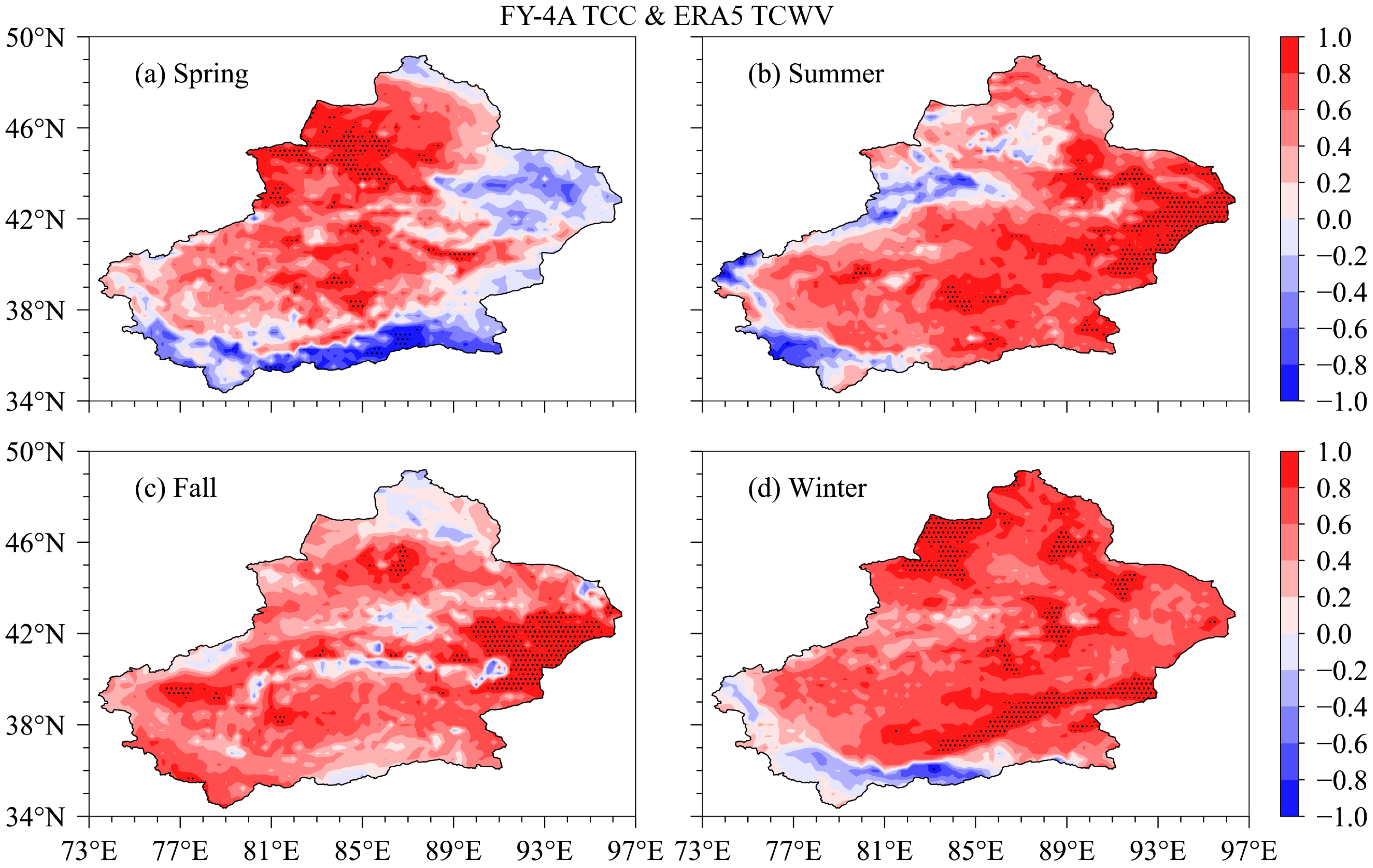
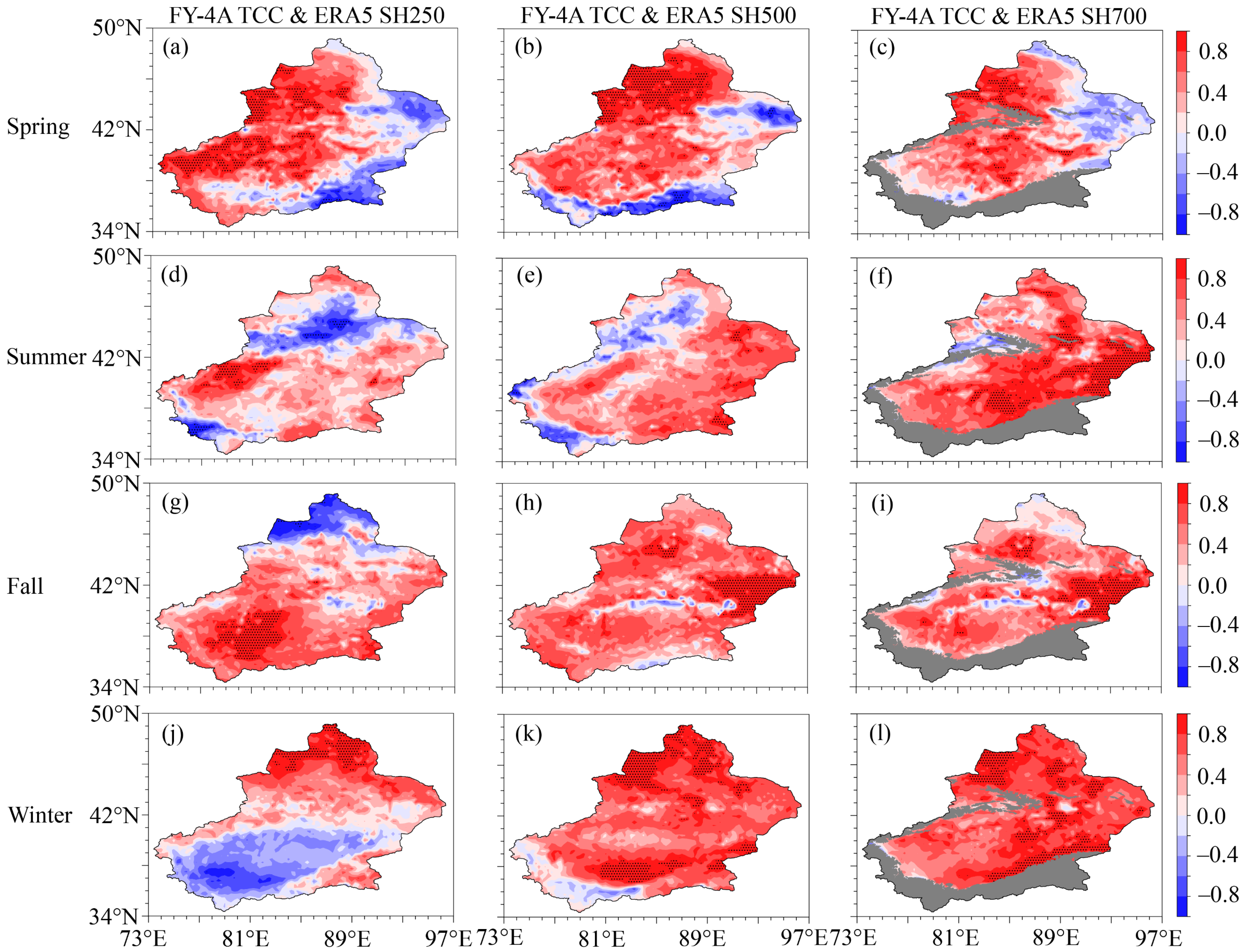
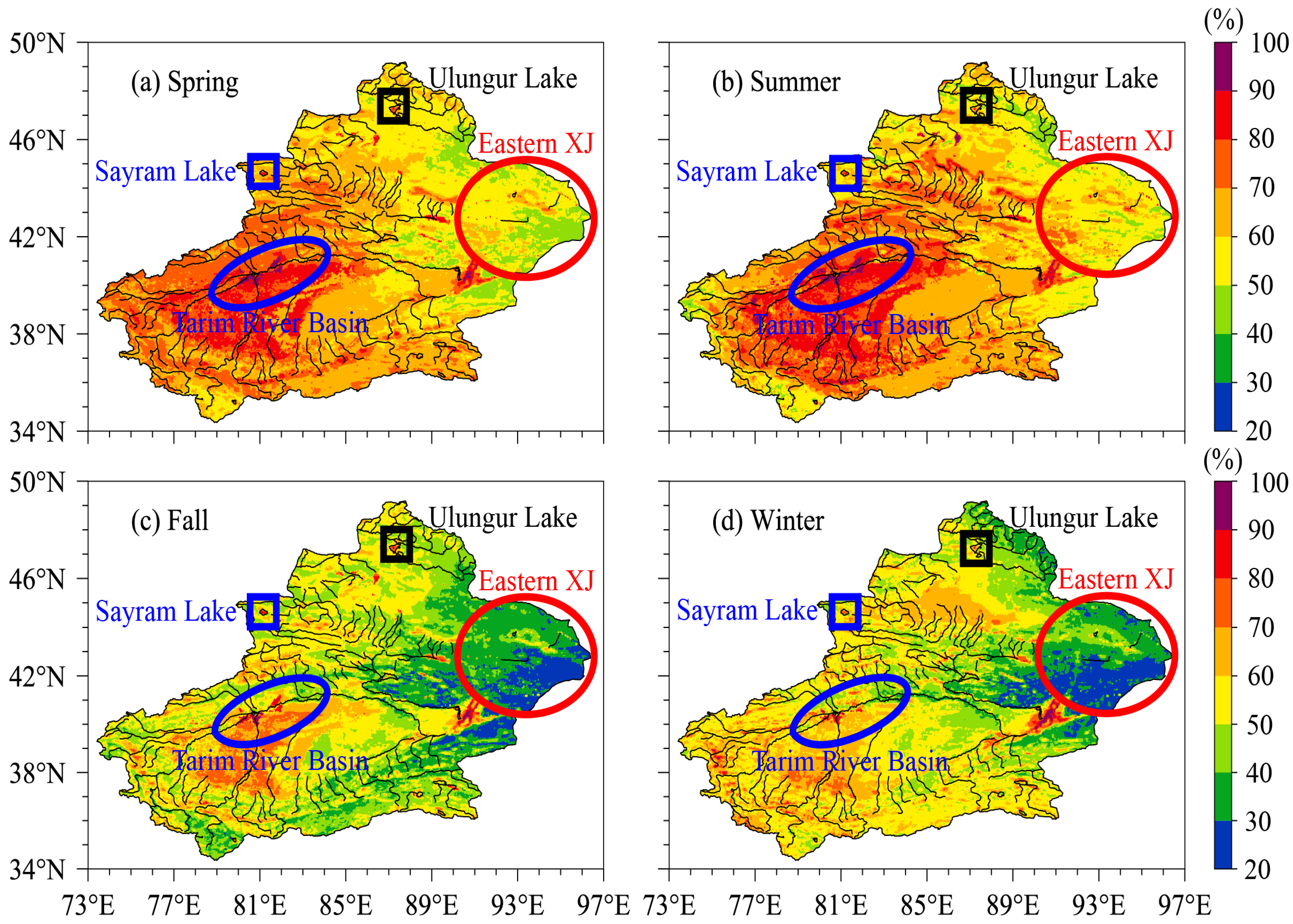
Disclaimer/Publisher’s Note: The statements, opinions and data contained in all publications are solely those of the individual author(s) and contributor(s) and not of MDPI and/or the editor(s). MDPI and/or the editor(s) disclaim responsibility for any injury to people or property resulting from any ideas, methods, instructions or products referred to in the content. |
© 2024 by the authors. Licensee MDPI, Basel, Switzerland. This article is an open access article distributed under the terms and conditions of the Creative Commons Attribution (CC BY) license (https://creativecommons.org/licenses/by/4.0/).
Share and Cite
Zeng, Y.; Yang, L.; Tong, Z.; Jiang, Y.; Zhou, Y.; Lu, X.; Abulikemu, A.; Li, J. Seasonal Variation in Total Cloud Cover and Cloud Type Characteristics in Xinjiang, China Based on FY-4A. Remote Sens. 2024, 16, 2803. https://doi.org/10.3390/rs16152803
Zeng Y, Yang L, Tong Z, Jiang Y, Zhou Y, Lu X, Abulikemu A, Li J. Seasonal Variation in Total Cloud Cover and Cloud Type Characteristics in Xinjiang, China Based on FY-4A. Remote Sensing. 2024; 16(15):2803. https://doi.org/10.3390/rs16152803
Chicago/Turabian StyleZeng, Yong, Lianmei Yang, Zepeng Tong, Yufei Jiang, Yushu Zhou, Xinyu Lu, Abuduwaili Abulikemu, and Jiangang Li. 2024. "Seasonal Variation in Total Cloud Cover and Cloud Type Characteristics in Xinjiang, China Based on FY-4A" Remote Sensing 16, no. 15: 2803. https://doi.org/10.3390/rs16152803





